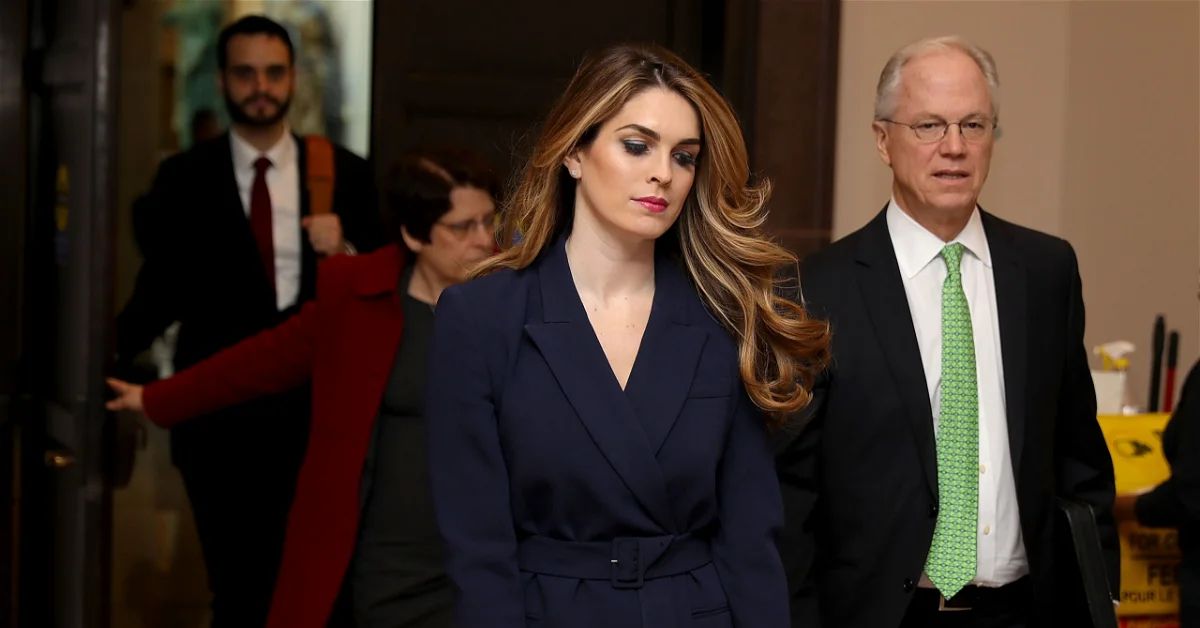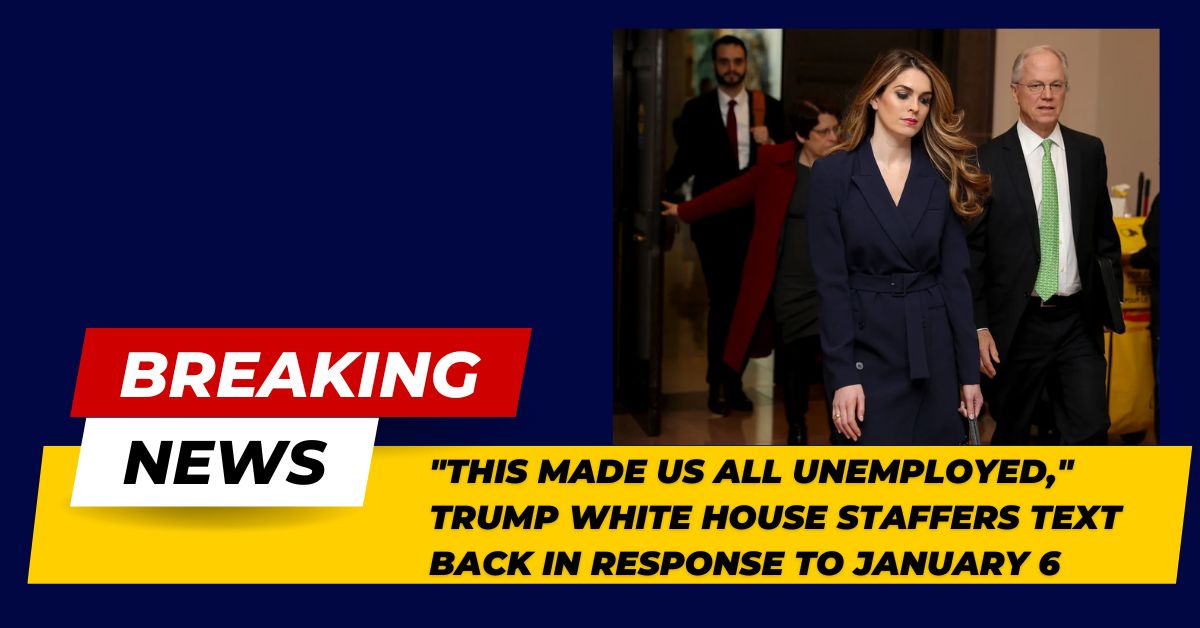“This Made Us All Unemployed,” Trump White House Staffers Text Back In Response To January 6: Newly released documents from the House select committee looking into the Capitol Hill uprising show that Ivanka Trump’s chief of staff, Julie Radford, and White House aide, Hope Hicks, talked about how angry they were with then-President Donald Trump’s actions on January 6, 2021, which hurt them professionally.
Hicks wrote to Radford on January 6, 2021, “in one day; he ended every future opportunity that wasn’t speaking at the local Proud Boys chapter.” “And those who didn’t already have jobs will be out of work for good. I’m so mad and upset. We all look like terrorists at home now.”
Hicks also said, “This made us all jobless. Like untouchable. God, I’m so pissed off.” Radford texted back, “I know, like there’s no chance of finding a job,” and said that she had already lost a job opportunity with Visa, which had sent her a “blow-off email.”
The committee has been putting out a steady stream of documents to go with the release of its 845-page report. This new release is one of those documents. The latest news comes as the panel’s work comes to an end. On Tuesday, when the new Congress starts, Republicans will take control of the House from Democrats.
Hicks then says, “Alyssa looks like a genius,” which seems to be a reference to the fact that Alyssa Farah Griffin quit her job as a White House aide a month before the attack on the US Capitol. Hicks and Radford then talk about how the supermodel Karlie Kloss, married to Jared Kushner and Ivanka Trump’s brother-in-law, tweeted that Trump’s response to the election was un-American. “Unreal,” Radford said in a text.
White House Call Logs Show More About Who Trump Talked To In The Days Before January 6
The committee also released call logs from the days before January 6, 2021. This gives a fuller picture of who the former President was talking to while he and his allies were plotting to keep him in office. This is the first time the committee has released all White House call logs.
The logs were critical to the investigation because they helped the panel put together a timeline of events. Even though there is a seven-hour gap in the log for January 6, the committee has worked hard to fill in that part of the timeline through interviews with witnesses and other records.
Trump talked to Vice President Mike Pence the day before the attack on the US Capitol. After that conversation, Trump spoke with Pennsylvania state Sen. Doug Mastriano, who helped Trump’s election lies in Pennsylvania. Then the switchboard operator left a note saying, “Senator Douglas Mastriano will call in for the Vice President.”
On January 5, Trump also talked to several members of Congress, such as Sens. Rand Paul, Lindsey Graham, and House Minority Leader Kevin McCarthy. Trump and Missouri Senator Josh Hawley tried to call each other many times but couldn’t get through. Trump also talked to John Eastman, who helped him develop the idea for the fake electors.
The January 2 call log shows what happened right after the famous hour-long call with Georgia Secretary of State Brad Raffensperger, during which Trump asked Raffensperger to “find” votes for him so he could win the state. After the call with Raffensperger ended, Trump had a zoom with his lawyer, Rudy Giuliani, and then talked on the phone with his Chief of Staff, Mark Meadows, and Steve Bannon.
On January 3, Trump talked to former Department of Justice worker Jeffrey Clark and GOP Rep. Scott Perry of Pennsylvania several times. The former President had tried to make Clark the acting head of the DOJ but ultimately failed. The call logs show that there were a lot of calls with DOJ officials, like Jeffrey Rosen, who was acting Attorney General at the time, and Richard Donoghue, Rosen’s assistant. At 4:22 p.m. ET that day, Clark is listed as the acting attorney general, but earlier in the day, he was not.

The Secret Service Sent Guards To The Capitol After Trump Said He Was Going To March On January 6
Newly released documents also show that the Secret Service sent a security team to the US Capitol on January 6, 2021, just a few minutes after Trump announced unexpectedly during his Ellipse speech that he would join marchers heading there.
At about 1:10 p.m. ET, Trump asked his supporters to “walk down Pennsylvania Avenue” with him to the Capitol. The Secret Service Joint Operations Center Counter Surveillance Unit sent an email around 1:15 p.m. ET to inform them that Trump had said “on LIVE TV that he plans to go to the Capitol with the crowd,” but his name was blacked out. The House Select Committee released this information.
“According to (redactedannouncement )’s to the Capitol, a response team will be sent to the Capitol,” the agents wrote in the email. When internal communications are made public, the code name agents use to talk about the President is often left out.
The newly released documents reveal how the Secret Service rushed to deal with the day’s chaos. The email from the joint operations center shows that the agency moved quickly to give the Capitol more security after hearing what the former President said.
The documents released by the committee show that the Secret Service leadership was worried about Trump’s sudden plan to go to the Capitol. The head of his detail was told that the idea was “not advisable.” They also talk about how the agency had technical problems and had to take back dozens of weapons on January 6. They also say that the Proud Boys’ plans to be violent were already known on December 27.
Multiple parts of the Secret Service were having problems with their technology, and agents were told in an email “not to rely” on it. The Secret Service gave the committee a timeline showing that some Secret Service radios stopped working during the worst chaos. Still, it’s unclear which protective teams were most affected.
Another document says that the Secret Service took away from about 28,000 people who went through the magnetometers on their way to the Ellipse hundreds of cans of pepper spray, body armor, and hundreds of weapons like knives and blunt weapons.
Trump’s Social Media Expert Said That The Former President “Does Do His Own Tweets”
Dan Scavino, Trump’s former deputy chief of staff and social media director, texted a rally organizer on January 6, 2021, after talking about the now-famous “will be wild” tweet from December 19, that Trump “does do his own tweets.” This is according to documents released by the select committee.
The panel and security experts say that the violence on January 6 was caused by a tweet from Trump’s account that promoted a big protest planned for that day.
Scavino and Katrina Pierson, who helped plan the rally at the Ellipse before the attack on the US Capitol, talked about a news story that linked the right-wing rally organizer Alexander Ali to the former President. “I’ve never talked to Ali… “He is a fake, and the tweet that DJT sent on December 19 had nothing to do with Ali or any of his people,” Scavino texted. “He does write his tweets.”
Please share your opinions on this post in the comments area if you found it helpful. Additionally, please visit our website Journalistpr.com. again soon for breaking news.

Leave a Reply